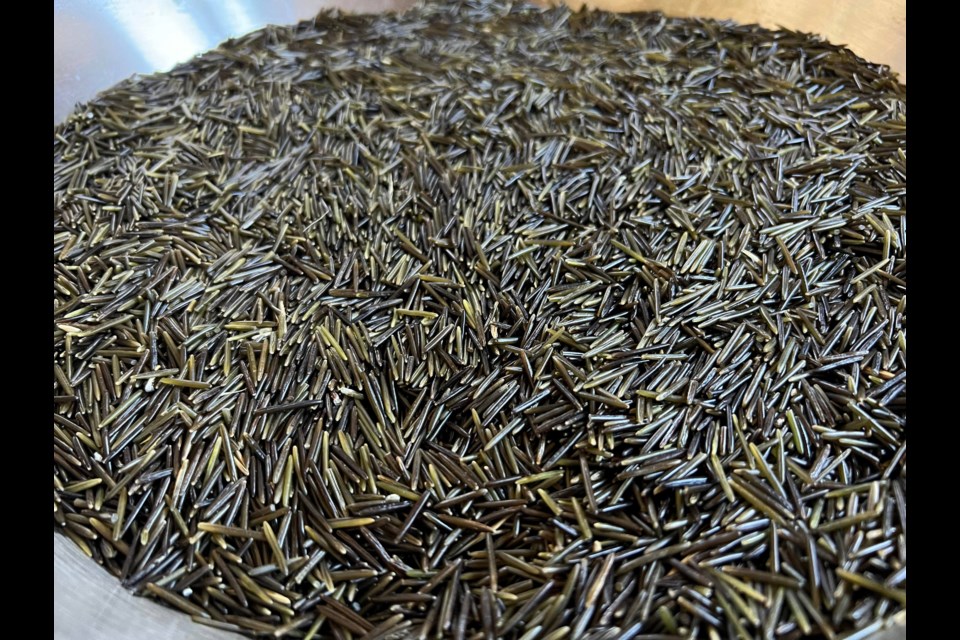The Council of Three Fires burns thousands of years after divine ignition scorched its great migration story into the hearts of the Great Lakes State, where Ojibwe, Ottawa, and Potawatomi drums beat to a language first told in Ojibwemowin.
Adhering to a dire warning delivered by spiritual teachers, the Anishinaabe migrated as far west as Minnesota in search of manoomin, translated to mean “good berry” in English. This was what the tribe called wild rice.
Bay Mills Indian Community member Wanda Perron shared what happened one extraordinary day countless generations ago when the Anishinaabe lived together along the country's east coast.
“We were doing well,” Perron said. “We had a good life. Then, spiritual beings came out of the water to warn us. They told us we must move west to the place where food grows on water.”
Engraved into birch bark scrolls is the story of the seven great miigism.
As explained by AAA Native Arts, seven iridescent beings appeared before tribal members to teach them about medicine in what became known as Midewiwin (Grand Medicine Society). One of the seven miigis beings killed tribal members before returning to the Alantic Ocean. Six miigis beings stayed to establish five doodem (clans), symbolized by various animals. Clans included the Wawaazisii (Bullhead), Baswenaazhi (Crane), Aan’aawenh (Duck), Nooke (Bear) and Moozoonsii (Little Moose).
The six miigis eventually returned to the ocean, but one reappeared to warn its people they must leave the area.
They separated into three flames in search of wild rice – Ojibwe, Ottawa, and Potawatomi – forever connected by a single legend.
All these years later, the Ojibwe of Bay Mills Indian Community have brought the indigenous food of their ancestors back to Bay Mills.
Perron's daughter, Karol Perron-Healy, is part of the initiative to reintroduce wild rice to the region.
“Reseeding and revitalization is a more recent effort in the last twenty years,” Perron-Healy said. “Wild rice was harvested in our region, but we lost it. It was eradicated due to several factors.”
She mentioned over-harvesting, industrial development, geese, and changing water levels.
According to the United States Department of Agriculture (USDA), wild rice is sensitive to its environment and difficult to establish because young plants are favored by muskrats, deer, fish, and migratory birds. In order for rice to grow in Michigan, water must be shallow and clear. It is suggested to seed in up to three-feet of water with at least six-inches of rich soil. Wild rice is best grown near the mouth of streams. The water’s PH, alkalinity, and sulfate ion levels are also important factors.
Bay Mills tribal members, along with volunteers from Lake Superior State University (LSSU) and BMCC, set out on Spectacle Lake and Waishkey Bay in kayaks and canoes to plant wild rice this September.
“We had a handful of families that harvested comfortably,” said Perron-Healy. “It is still establishing itself. It is still not enough for everyone in the community to harvest.”
The tribal elder food program received a portion of the wild rice harvested. The rest will be enjoyed by families and shared at seasonal feasts.
“There are many indigenous cookbooks with wild rice,” said Perron, going on to state, “Food is Medicine.”
Registered Dietician Kayla McDonnell described wild rice grown as a species of grass that produces edible seeds. In a Healthline article, McDonnell revealed its nutritional value:
A 3.5-ounce (100-gram) serving of cooked wild rice provides:
- Calories: 101
- Carbs: 21 grams
- Protein: 4 grams
- Fiber: 2 grams
- Vitamin B6: 7% of the Daily Value (DV)
- Folate: 6% of the DV
- Magnesium: 8% of the DV
- Phosphorus: 8% of the DV
- Zinc: 9% of the DV
- Copper: 6% of the DV
- Manganese: 14% of the DV
Wild rice contains high amounts of protein, manganese, phosphorus, magnesium, and zinc. Nutritional health benefits could be considered medicinal in Midewiwin practices.
Ojibwe recipes containing wild rice can be found on the Native Harvest Ojibwe Project of White Earth Land Recovery Project website, here, but feel free to search around to find new ways to incorporate wild rice into your next feast.



